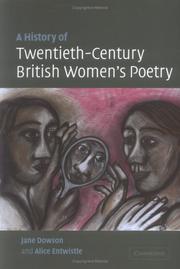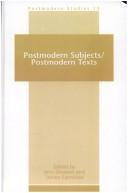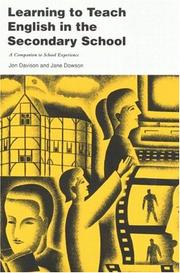| Listing 11 - 17 of 17 | << page >> |
Sort by
|
Book
ISBN: 9783039368815 Year: 2020 Publisher: Basel MDPI
Abstract | Keywords | Export | Availability | Bookmark
 Loading...
Loading...Choose an application
- Reference Manager
- EndNote
- RefWorks (Direct export to RefWorks)
Book
ISBN: 9781137415622 Year: 2016 Publisher: London : Palgrave Macmillan,
Abstract | Keywords | Export | Availability | Bookmark
 Loading...
Loading...Choose an application
- Reference Manager
- EndNote
- RefWorks (Direct export to RefWorks)
This is the only monograph to consider the entire thirty-year career, publications, and influence of Britain's first female poet laureate. It outlines her impact on trends in contemporary poetry and establishes what we mean by 'Duffyesque' concerns and techniques. Discussions of her writing and activities prove how she has championed the relevance of poetry to all areas of contemporary culture and to the life of every human being. Individual chapters discuss the lyrics of 'love, loss, and longing'; the socially motivated poems about the 1980s; the female-centred volumes and poems; the relationship between poetry and public life; and poetry and childhood and written for children. The book should whet the appetite of readers who know little of Duffy's work to find out more, while providing students and scholars with an in-depth analysis of the poems in their contexts. It draws on a wide range of critical works and includes an extensive list of further reading.
Book
Year: 2020 Publisher: Basel, Switzerland MDPI - Multidisciplinary Digital Publishing Institute
Abstract | Keywords | Export | Availability | Bookmark
 Loading...
Loading...Choose an application
- Reference Manager
- EndNote
- RefWorks (Direct export to RefWorks)
This Special Issue showcases poets who enhance the breadth of modernist literary practices. The cohering concept is a complex relationship to both gender and modernity through original experiments with language. Leading scholars explore writers who both fit and extend orthodox modernist histories: Marianne Moore, H.D., Edna St Vincent Millay, Dorothy Parker, Katherine Mansfield, and Charlotte Mew were born around the cusp of the twentieth century and flourished during the 1920s and 1930s; Lynette Roberts, Helen Adam and Hope Mirrlees were contemporaries but publishing or recognition came later; the next generation can include Gwendolyn Brooks, Stevie Smith and Muriel Spark; Veronica Forrest-Thomson represents a third generation who published into the 1980s, while Frances Presley and M. NourbeSe Philip hinge this group with the contemporary poets Carol Watts and Natasha Trethewey, whose works continue and rejuvenate progressive stylistics. The essays offer new readings of both well-known and unfamiliar poets. They are truly groundbreaking in plundering diverse theoretical fields in ways that disturb any lingering notions of a homogenized women’s poetry. The authors supplant into literary poetic analysis notions of geometry and mathematics, maritime materialities, tourism and taxonomy, architecture, classicism, folk art, Christianity and death, whimsy and empathy.
Literature & literary studies --- H.D. --- Helen in Egypt --- Adorno --- late modernism --- epic --- avant-garde --- Gwendolyn Brooks --- architecture --- modernity --- Chicago --- Katherine Mansfield --- symbolism --- fin-de-siècle --- decadence --- modernism --- poetry --- Arthur Symons --- Stevie Smith --- T.S. Eliot --- The Waste Land --- Greek gods --- female protagonists --- Christianity --- suicide --- death --- Charlotte Mew --- Modernism --- empathy --- Edna St. Vincent Millay --- masculinity --- lyric --- drama --- verse drama --- gender --- genre --- race --- tourism --- taxonomy --- poetics --- Marianne Moore --- Natasha Trethewey --- Thomas Jefferson --- Scotland --- ballads --- kaleidoscope --- Charles Bernstein --- Edwin Morgan --- folk art --- Welsh Modernism --- Feminism --- nationalism --- ethnography --- geomodernisms --- modernist poetics --- Caribbean poetry --- Zong! --- M. NourbeSe Philip --- black poetry --- critical ocean studies --- multispecies --- materiality --- ecocriticism --- Moore --- Parker --- whimsy --- New York --- geometry --- place --- site-specific poetry --- mathematics --- metaphor --- Exmoor --- mid-Wales --- stone settings --- Zeta function --- prime numbers --- pastoral --- H.D. --- Helen in Egypt --- Adorno --- late modernism --- epic --- avant-garde --- Gwendolyn Brooks --- architecture --- modernity --- Chicago --- Katherine Mansfield --- symbolism --- fin-de-siècle --- decadence --- modernism --- poetry --- Arthur Symons --- Stevie Smith --- T.S. Eliot --- The Waste Land --- Greek gods --- female protagonists --- Christianity --- suicide --- death --- Charlotte Mew --- Modernism --- empathy --- Edna St. Vincent Millay --- masculinity --- lyric --- drama --- verse drama --- gender --- genre --- race --- tourism --- taxonomy --- poetics --- Marianne Moore --- Natasha Trethewey --- Thomas Jefferson --- Scotland --- ballads --- kaleidoscope --- Charles Bernstein --- Edwin Morgan --- folk art --- Welsh Modernism --- Feminism --- nationalism --- ethnography --- geomodernisms --- modernist poetics --- Caribbean poetry --- Zong! --- M. NourbeSe Philip --- black poetry --- critical ocean studies --- multispecies --- materiality --- ecocriticism --- Moore --- Parker --- whimsy --- New York --- geometry --- place --- site-specific poetry --- mathematics --- metaphor --- Exmoor --- mid-Wales --- stone settings --- Zeta function --- prime numbers --- pastoral

ISBN: 0521819466 9780521819466 Year: 2005 Publisher: Cambridge Cambridge University press
Abstract | Keywords | Export | Availability | Bookmark
 Loading...
Loading...Choose an application
- Reference Manager
- EndNote
- RefWorks (Direct export to RefWorks)
820-1 "19" --- Engelse literatuur: poëzie--20e eeuw. Periode 1900-1999 --- English poetry --- Women and literature --- Women authors --- History and criticism. --- History --- 820-1 "19" Engelse literatuur: poëzie--20e eeuw. Periode 1900-1999 --- English literature --- Women authors&delete& --- History and criticism

Abstract | Keywords | Export | Availability | Bookmark
 Loading...
Loading...Choose an application
- Reference Manager
- EndNote
- RefWorks (Direct export to RefWorks)

Abstract | Keywords | Export | Availability | Bookmark
 Loading...
Loading...Choose an application
- Reference Manager
- EndNote
- RefWorks (Direct export to RefWorks)
How do you approach teaching English in the contemporary classroom? What is expected of a would-be English teacher? The fourth edition of this best-selling text combines theory and practice to present an indispensable introduction to the opportunities and challenges of teaching English in the secondary classroom. It offers insight into the history, policies and definitions surrounding the subject, together with innovative and practical strategies which can be used for effective teaching and learning. Already a major text for many university teacher education courses, the new edition reflects the extent and impact of current reforms whilst retaining its focus on what is of enduring value for English teaching.? With an emphasis on developing your own values and on stimulating approaches that underpin English teaching, it will help you navigate your way through changing curriculum requirements, assessment practice and the demands of professional development.?? Key topics explored include: Reading, writing and speaking and listening Teaching language and grammar Drama in English teaching Poetry Working with digital technologies Post-16 English language and literature Developing as a critically reflective practitioner. Written particularly with the new and student teacher in mind, Learning to Teach English in the Secondary School aims to equip readers with the tools to make critically informed judgements about how to teach, develop principled practice and most importantly, be mindful of pupils and their experience of English in the secondary classroom.
English language --- English literature --- English teachers --- Lerarenopleiding --- Study and teaching (Secondary) --- Training of --- (vak)didactiek talen.
Book
ISBN: 0415491665 9780415491662 0415491657 9780415491655 0203871146 9780203871140 Year: 2009 Publisher: London Routledge
Abstract | Keywords | Export | Availability | Bookmark
 Loading...
Loading...Choose an application
- Reference Manager
- EndNote
- RefWorks (Direct export to RefWorks)
| Listing 11 - 17 of 17 | << page >> |
Sort by
|

 Search
Search Feedback
Feedback About UniCat
About UniCat  Help
Help News
News